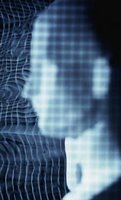Enhancing Memory with Visual Flicker
 According to a new article in BMC Neuroscience, it's possible to improve some types of memory simply by watching something that turns on and off around 10 times per second. This "flicker frequency" of 10 Hz is thought to enhance recognition memory by amplifying rhythmic slow activity, which is known to be important in memory function.
According to a new article in BMC Neuroscience, it's possible to improve some types of memory simply by watching something that turns on and off around 10 times per second. This "flicker frequency" of 10 Hz is thought to enhance recognition memory by amplifying rhythmic slow activity, which is known to be important in memory function.Alpha band power, which includes 10 Hz, decreases in both Alzheimer's and the typical elderly. This suggests that alpha power may be related to the diminishing episodic memory of those populations. Long-term potentiation is also enhanced by such rhythmic slow activity (RSA). Drugs such as ACTH 4-10 and liptropin as well as brain stimulation techniques that affect RSA also seem to affect memory.
However, many might argue that RSA is merely "epiphenomenal" - meaning that it was a side-effect of actual memory processes, rather than an integral mechanism of these processes. According to this account, skeptics might claim that drugs and brain stimulation affect the mechanisms themselves, which in turn give rise to altered EEG activity. Likewise, the different EEG activity in the elderly is due to an age-related change to the underlying mechanism, which is not related to alpha rhythms or RSA per se.
In contrast, this study and other recent work firmly establish a causal role for RSA in memory function. In this work, human subjects are given a list of words to study, and are later asked to identify which words they actually saw. If subjects are shown LEDs flickering at a frequency of 10Hz (or its harmonics) for 1 sec prior to the test phase, their recognition performance is significantly increased relative to those who experienced a flicker at 9 Hz, 11.5 Hz, or no flicker at all. Furthermore, this paradigm is capable of elevating the performance of elderly subjects to that of young adults.
Finally, this visual flicker is effective even if it is presented peripherally. This technique, as well as the related findings I posted about yesterday, have fascinating implications for non-pharmacological memory enhancement technology.


2 Comments:
Thanks Chris! I've heard about these studies and meant to track them down & post on them, but didn't get around to reading them until just last week.
Keep up the great work with Myomancy.
This is interesting. From what I know from neurofeedback, the exact frequency being trained is very important to get the best benefits and there is considerable variation between peak alpha's of people. A peak alpha from 10.5-11.5 might be expected from a normal adult.
Therefore it comes as a surprise that 11.5 hz didn't work as well as 10 hz.
Could it then be the light... I think I've read people having done EEG's while hooked up flashing lights and seeing the flash frequency as dominant.
Thanks, this leaves me with questions.
Post a Comment
<< Home